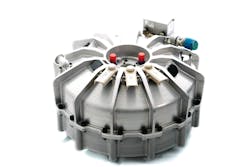Today Williams Hybrid Power — a division of the Williams group of companies that includes the Williams F1 Team — and Alstom Transport have signed an agreement that will see Williams Hybrid Power’s energy storage technology applied to Alstom’s Citadis trams by 2014.
Williams Hybrid Power and Alstom have entered an exclusive relationship that will see the two companies work together to adapt and develop an energy storage solution that has the potential to reduce the greenhouse gas emissions of Alstom’s rolling stock. After several years of research into energy storage, Alstom has teamed up with Williams Hybrid Power to trial its composite MLC flywheel energy storage technology which offers potential fuel savings of 15 percent when installed in public transport applications.
Originally developed for the 2009 Williams Formula One car, Williams Hybrid Power’s energy storage technology has since been introduced into applications such as London buses and the Le Mans winning Audi R18 e-tron quattro. The technology offers fuel savings and emissions reductions by harvesting the energy that is normally lost as heat when braking and turning it into additional power. It is ideally suited to trams because of their stop-start nature and high mass. Furthermore, the flywheel’s rotor is made of composite material which is inherently safe because there is no metallic structure travelling at very high speed.
"As a world leader in rail transport technology, Alstom is continuously looking to challenge and improve the energy efficiency of its trains,” said Dominique Jamet, innovation director at Alstom Transport. “We are proud to announce the collaborative project with Williams Hybrid Power that aims to deliver an innovative solution that does not only save energy but also re-use it to add more power to the tram while reducing energy use and CO2 emissions."
Ian Foley, managing director of Williams Hybrid Power, commented: “From the very beginning we highlighted trams as an ideal application for our technology and to be collaborating with the market leader on this project is very exciting. We both share a common goal — developing the next generation of green transport technologies — and this agreement will hopefully prove pivotal in finding a solution that not only cuts carbon emissions but crucially cuts costs for the end user.’’



